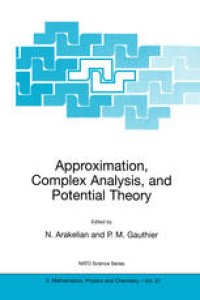
Ebook: Approximation, Complex Analysis, and Potential Theory
- Tags: Computational Mathematics and Numerical Analysis, Fluid- and Aerodynamics, Partial Differential Equations, Applications of Mathematics
- Series: NATO Science Series 37
- Year: 2001
- Publisher: Springer Netherlands
- Edition: 1
- Language: English
- pdf
Hermann Weyl considered value distribution theory to be the greatest mathematical achievement of the first half of the 20th century. The present lectures show that this beautiful theory is still growing. An important tool is complex approximation and some of the lectures are devoted to this topic. Harmonic approximation started to flourish astonishingly rapidly towards the end of the 20th century, and the latest development, including approximation manifolds, are presented here.
Since de Branges confirmed the Bieberbach conjecture, the primary problem in geometric function theory is to find the precise value of the Bloch constant. After more than half a century without progress, a breakthrough was recently achieved and is presented. Other topics are also presented, including Jensen measures.
A valuable introduction to currently active areas of complex analysis and potential theory. Can be read with profit by both students of analysis and research mathematicians.
Hermann Weyl considered value distribution theory to be the greatest mathematical achievement of the first half of the 20th century. The present lectures show that this beautiful theory is still growing. An important tool is complex approximation and some of the lectures are devoted to this topic. Harmonic approximation started to flourish astonishingly rapidly towards the end of the 20th century, and the latest development, including approximation manifolds, are presented here.
Since de Branges confirmed the Bieberbach conjecture, the primary problem in geometric function theory is to find the precise value of the Bloch constant. After more than half a century without progress, a breakthrough was recently achieved and is presented. Other topics are also presented, including Jensen measures.
A valuable introduction to currently active areas of complex analysis and potential theory. Can be read with profit by both students of analysis and research mathematicians.
Hermann Weyl considered value distribution theory to be the greatest mathematical achievement of the first half of the 20th century. The present lectures show that this beautiful theory is still growing. An important tool is complex approximation and some of the lectures are devoted to this topic. Harmonic approximation started to flourish astonishingly rapidly towards the end of the 20th century, and the latest development, including approximation manifolds, are presented here.
Since de Branges confirmed the Bieberbach conjecture, the primary problem in geometric function theory is to find the precise value of the Bloch constant. After more than half a century without progress, a breakthrough was recently achieved and is presented. Other topics are also presented, including Jensen measures.
A valuable introduction to currently active areas of complex analysis and potential theory. Can be read with profit by both students of analysis and research mathematicians.
Content:
Front Matter....Pages i-xix
Approximation and value distribution....Pages 1-28
Uniform and tangential harmonic approximation....Pages 29-71
Sobolev spaces and approximation problems for differential operators....Pages 73-106
Holomorphic and harmonic approximation on Riemann surfaces....Pages 107-128
On the Bloch constant....Pages 129-161
Approximation of subharmonic functions with applications....Pages 163-189
Harmonic approximation and its applications....Pages 191-219
Jensen measures....Pages 221-237
Simultaneous approximation in function spaces....Pages 239-261
Back Matter....Pages 263-264
Hermann Weyl considered value distribution theory to be the greatest mathematical achievement of the first half of the 20th century. The present lectures show that this beautiful theory is still growing. An important tool is complex approximation and some of the lectures are devoted to this topic. Harmonic approximation started to flourish astonishingly rapidly towards the end of the 20th century, and the latest development, including approximation manifolds, are presented here.
Since de Branges confirmed the Bieberbach conjecture, the primary problem in geometric function theory is to find the precise value of the Bloch constant. After more than half a century without progress, a breakthrough was recently achieved and is presented. Other topics are also presented, including Jensen measures.
A valuable introduction to currently active areas of complex analysis and potential theory. Can be read with profit by both students of analysis and research mathematicians.
Content:
Front Matter....Pages i-xix
Approximation and value distribution....Pages 1-28
Uniform and tangential harmonic approximation....Pages 29-71
Sobolev spaces and approximation problems for differential operators....Pages 73-106
Holomorphic and harmonic approximation on Riemann surfaces....Pages 107-128
On the Bloch constant....Pages 129-161
Approximation of subharmonic functions with applications....Pages 163-189
Harmonic approximation and its applications....Pages 191-219
Jensen measures....Pages 221-237
Simultaneous approximation in function spaces....Pages 239-261
Back Matter....Pages 263-264
....